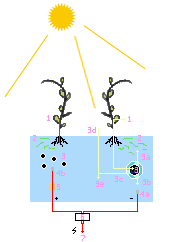
- Image via Wikipedia
A new study finds a previous estimate of wastewater’s potential as a renewable energy source “a substantial underestimation”
Is what you flush down the toilet wasted energy? People living in countries with flush-toilets and running water produce a huge amount of wastewater daily. This water, thanks largely to excrement, is full of organic compounds that store usable energy in their chemical bonds. Several methods can be employed to harvest it—for example, engineers can extract methane through anaerobic (oxygen-free) digestion, or produce electricity using microbial fuel cells.
In the past several years an increasing amount of research has focused on developing and improving on these methods, as harnessed sewage power could help water treatment plants produce enough power to meet all their own consumption—and even serve as a fuel source in developing countries where supplies are currently unreliable. But just how much usable energy does raw sewage hold? This was the question posed by the authors of a study published January 5 in Environmental Science & Technology. Their answer: wastewater likely holds a lot more than was previously thought.
Elizabeth Heidrich, a PhD student at Newcastle University in England and lead author of the new study, studies microbial fuel cells—devices that generate electrical current by capturing the electrons freed as bacteria break down organic matter in wastewater. As she was preparing her doctoral research project she decided to determine how much energy engineers could count on wastewater to provide. “It seemed like an obvious question to start with,” she explains—which was why she was surprised that hardly anyone had previously asked it.
Heidrich found only one study, published in 2004, which had tried answer to the question. The authors had tested a sample of raw municipal sewage collected from a Toronto treatment plant and, using calorimetry (the measurement of heat absorption and emission), calculated the internal chemical energy of the sample to be 6.3 kilojoules per liter. They also correlated the amount of energy found in the sample to its chemical oxygen demand (COD), a commonly used indirect measurement of dissolved organic compounds. Based on this correlation, they estimated that, in all, the wastewater produced in 2004 by the world’s 6.8 billion people contained a continuous supply of energy somewhere in the range of 70 to 140 gigawatts. (One large nuclear plant produces around 1 gigawatt).
Related articles
- Making Bacteria Clean Water and Generate Electricity (spectrum.ieee.org)
- Household sewage: Not waste, but a vast new energy resource (sciencedaily.com)
- The Untapped Energy In Wastewater (pubs.acs.org)









